Have you ever come across vanilla sugar in a recipe and wondered what it was? A widely popular sweetener in Europe, vanilla sugar is essentially a flavored sugar. This ingredient provides a fragrant sweetness when used in sauces, baked goods, cold confections, and even in your coffee.
If you’re looking to try this luxe ingredient in your cooking, but don’t have it or can’t find it in shops, you can easily make a quick vanilla sugar substitute with just two pantry ingredients - granulated sugar and vanilla extract.
If you’ve also run out of vanilla extract, read on to learn more about vanilla sugar and how to make vanilla sugar at home or source other substitutes for vanilla sugar.
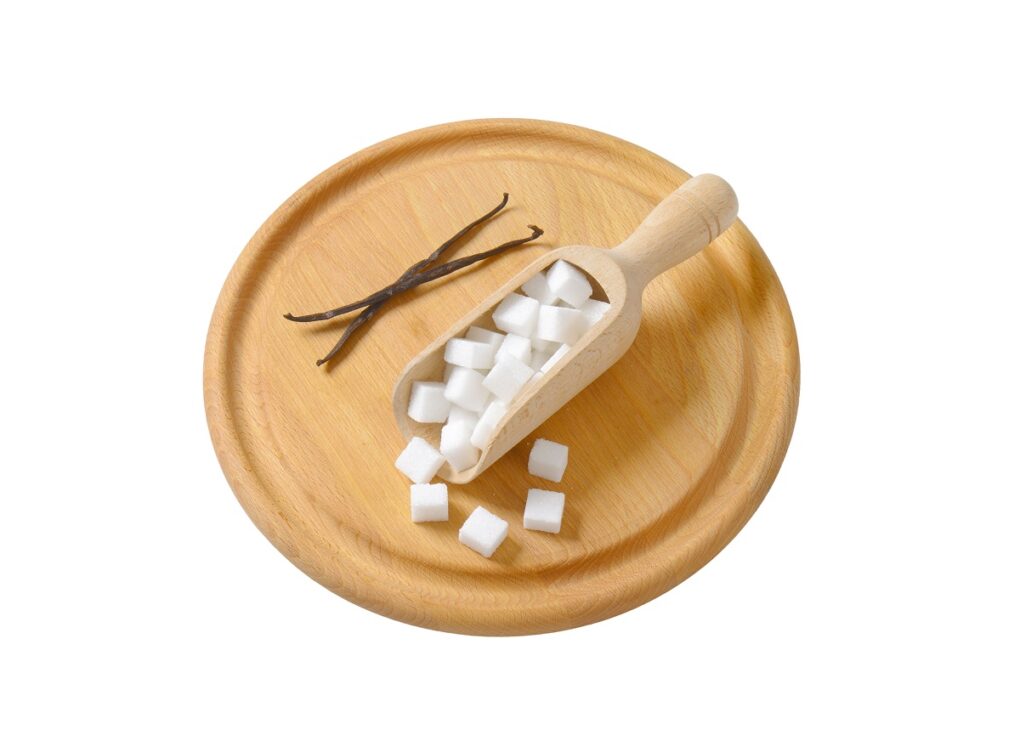
Jump to:
What is Vanilla Sugar?
Vanilla sugar is made up of vanilla beans and sugar. Some recipes combine vanilla extract and sugar, while commercial versions generally add artificial flavoring to sugar. The flavor is predominantly sweet because sugar is the dominant ingredient, enhanced by vanilla.
Often described as sweet, marshmallow-like with spice and a slightly floral fragrance, vanillin is the compound responsible for all of these wonderful elements.
A member of the orchid family, vanilla is native to South and Central America. The Totonacs of Mexico were believed to be the first to cultivate the beans, but the Spanish brought them to Europe. Thousands of years back, the Aztecs were known to mix vanilla into their cacao drinks, the French into ice cream, and the Americans into soda.
Long before the rise of imitation vanilla, pure vanilla sugar was used as a cost-effective way to get as much value as possible from expensive vanilla beans.
Vanilla sugar is a more common ingredient in Central Europe than it is in the United States or the United Kingdom, where the preferred iteration of the bean is vanilla extract. You can find vanilla sugar online and in brick-and-mortar specialty shops; look out for natural or pure varieties rather than imitation ones.

How to Use Vanilla Sugar
Vanilla sugar is commonplace in Europe as a flavored sweetener for baking and sweet culinary applications. It shows up in many recipes, such as a German vanillezucker, Austrian vanillekipferl, Dutch oliebollen, and many more.
The most popular function of vanilla sugar is as a finishing sugar sprinkle onto baked goods. The sweetener adds to the aesthetics of pastries and gives them a wonderful crunch.
Many look to vanilla sugar made with real vanilla beans as an alcohol-free alternative to vanilla extract. It contains no alcohol at all, so it is kid-friendly and suitable for patients recovering from illness. The most basic use of vanilla sugar is the convenience of getting the flavors of both vanilla and sugar together in a recipe as one ingredient.
Vanilla sugar is a wonderful substitute for vanilla extract in a recipe when you’ve run out. It accomplishes the same thing as vanilla extract, without adding moisture or alcohol to your dish. In recipes that call for vanilla extract, start by adding a lesser amount of vanilla sugar than your vanilla extract, and work your way up according to taste.

Here are other ways of using vanilla sugar:
- Make a simple syrup to add flavor to cocktails and other beverages.
- Use as a vanilla-flavored sugar substitute for granulated sugar in cake batter, cookie dough, scones, muffins, and more.
- Try it as a sweetener for coffee, tea, cocoa, and smoothies.
- Sprinkle on oatmeal, muffins, cupcakes, cookies, or sticky rice cakes.
- As an alternative to cinnamon sugar in French toast, snicker-doodles, or sticky buns.
- To replace expensive vanilla beans in a recipe. Not only is it cost-efficient, but it allows you to skip a step and save time.
- Use in ice cream and other cold confections to add richness and depth.
- Use as a vanilla flavored powdered sugar for donuts, crinkles, bars, or whipping cream.
When using vanilla sugar in recipes, you can always put in less in the beginning and add in some more if a stronger vanilla taste or sweetness is desired. Here are some vanilla sugar recipes for you to try:
- Smoothie Bowl
- Pavlova
- Pancakes, Waffles, and French toast batter
- Cookies
- Cakes
- Whoopie Pies
- Overnight Oats
- Muesli Bread
One last thing before we move on to substitutes. Vanilla sugar is a gourmet food product, often seen on the shelves of artisan bake shops and specialty stores. Resist splurging, and instead, make a small batch for personal consumption. Similarly, you can increase the quantity, pack them in nice jars or containers, and give them away as luxe, homemade special occasion gifts.

Best Vanilla Sugar Substitutes
When looking for a substitute for vanilla sugar, any one of the applications mentioned above will have a suitable option on the list below.
We’ve come up with lots of natural sugar alternatives, because white sugar is basically empty calories. These sugars don’t get enough recognition as an option, but they all taste great and are a lot better for your health. Most of these natural sugars only sweeten and won’t replace the vanilla flavor in your dish, so to offset the taste, add a few drops of vanilla extract to your recipe.
After the sugars, we’ll move on to a handful of vanilla sugar hacks using vanilla flavoring - extract, bean, or powder. Plus, a few other natural sweeteners that you may have in stock.
DIY Vanilla Sugar: Sugar and Vanilla Bean
The best substitute for vanilla sugar is to make your vanilla sugar. It’s really easy to make. All you need are granulated sugar and a vanilla pod or two.
When making your own, opt for granulated sugar because the sweetness tends to be more prominent than in other sugars. Of course, if you’re on an elimination diet or looking for a healthy sugar substitute, don’t let us stop you from choosing a more natural sugar. Some of the sugars listed above are great options to start with.
Using fresh vanilla beans will give you the best flavor, as well as those beautiful vanilla bean flecks. The ratio of vanilla bean to sugar is up to you; you can adjust this according to taste. Keep in mind that the longer you wait to use your vanilla sugar, the more vanilla flavor the sugar will take on.
There are a few ways to make this, using a blender ,that will give you a super fine vanilla sugar. This sweet vanilla-scented dust will be delicious sprinkled on anything or everything. You can split the pods and put them in directly, or scrape the beans then put them in, but both of these options will turn your sugar brown.
Once combined, you can shake the mixture once a day or every few days, then use it in a 1:1 ratio.
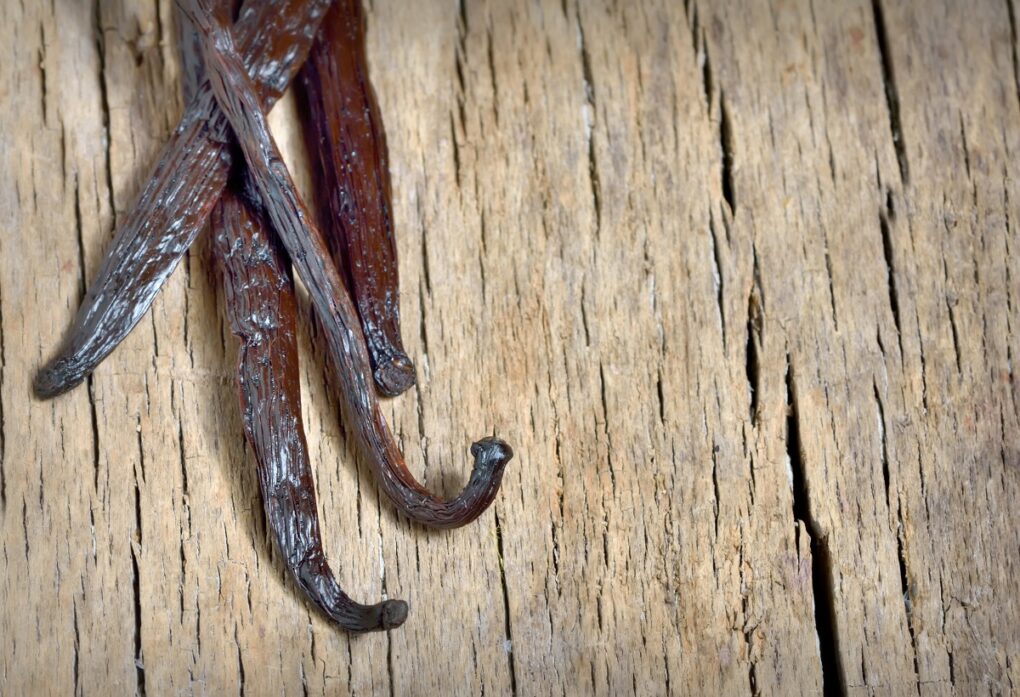
DIY Vanilla Sugar: Sugar and Vanilla Extract
If you don’t have fresh or dried vanilla beans, but do have a bottled extract, use this concentrated flavoring to make vanilla sugar.
Simply combine vanilla extract with sugar. Your sugar will brown a little from the deep color of the extract, but the flavor will be robust. Shake thoroughly and use it as you would any other kind of vanilla sugar. You need no fancy measurements for this swap; just use a 1:1 ratio.
DIY Vanilla Sugar: Sugar and Vanilla Bean Paste
Another vanilla product that offers the same rich, intense flavor to recipes is vanilla bean paste. It is made by mixing pure vanilla and sugar to achieve a viscous, concentrated flavoring.
The ease of convenience of using this type of vanilla is that you won’t have to scrape the beans into your sugar. The downside is that the paste changes the color of the sugar, turning it rather dark brown and making it lumpy. As always, use a ratio that works well for you in terms of flavor and color, but start by adding a teaspoon to each cup of sugar.
Use this as a 1:1 substitute for flavoring cakes, cookies, and bars. ice creams and many other sweet confections.
DIY Vanilla Sugar: Sugar and Vanilla Powder
Vanilla powder is a fine powder made from ground vanilla beans. Unlike vanilla extract, it’s an alcohol-free version of the flavoring, almost dry and similar to the texture of vanilla sugar.
A teaspoon of vanilla powder mixed into a cup of sugar is a great alternative to vanilla sugar. It works well when combined with other ingredients, like in baked goods. Homemade vanilla powder has a concentrated flavor that makes the vanilla the center of attention of this DIY vanilla sugar hack. Use in a 1:1 ratio.
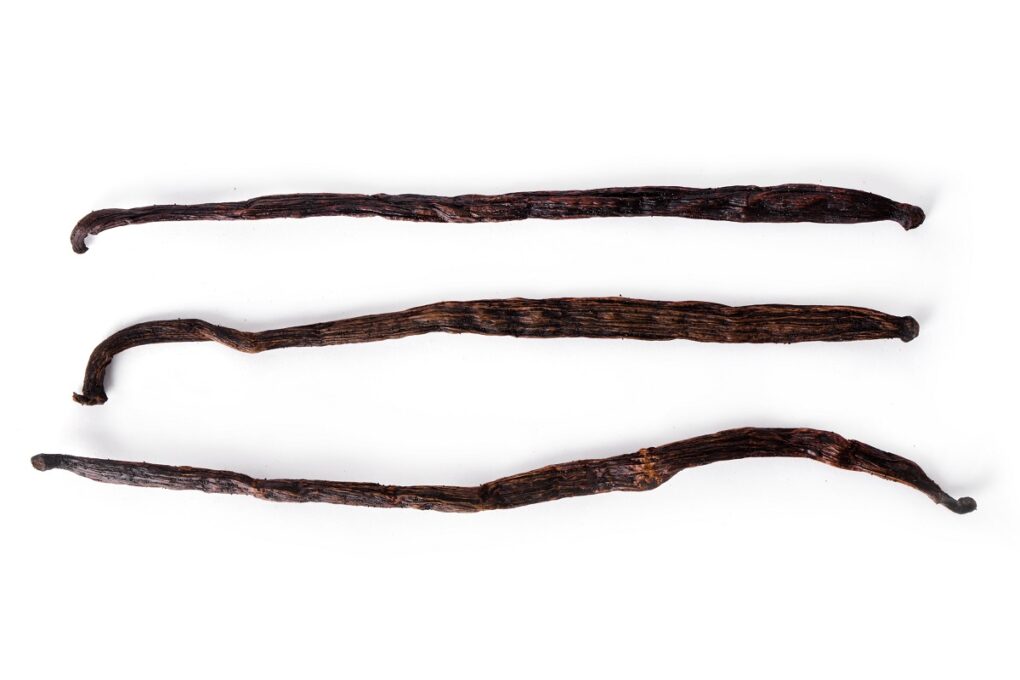
Vanilla Syrup
Despite being a liquid, if your recipe with vanilla sugar calls for other liquids, vanilla syrup can make for a great vanilla sugar substitute. For this swap you can use either homemade vanilla simple syrup or a store bought flavored syrup. Use in a 1:1 ratio, by volume.
Vanilla Extract
Vanilla extract is a common pantry ingredient, especially if you’re into baking. Vanilla extract adds richness, complexity, and a slight sweetness to your recipe. For these reasons, vanilla extract is a great alternative to vanilla sugar.
This sub will not make your recipe sweet, but provides great depth of flavor in baked goods. Most of these applications will have some form of sweetener anyway, so use this alternative when you want to add vanilla’s flavor profile more so than sweetness.
Vanilla extract works well as a vanilla sugar sub in recipes that call for smooth results, because it will blend more easily with the other ingredients. Frostings, icings, and whipped creams come to mind for this purpose. Vanilla extract can’t be used as a substitute in recipes that call for vanilla sugar as a topping or finishing sugar.
Turbinado Sugar
For this first vanilla sugar swap without actual vanilla flavor, I'd recommend turbinado sugar. Not only is it great for decorating cakes & cookies and rimming chocolate beverages, but it also has a pleasant underlying complexity that mirrors that of vanilla sugar. Use it as a 1-to-1 replacement.
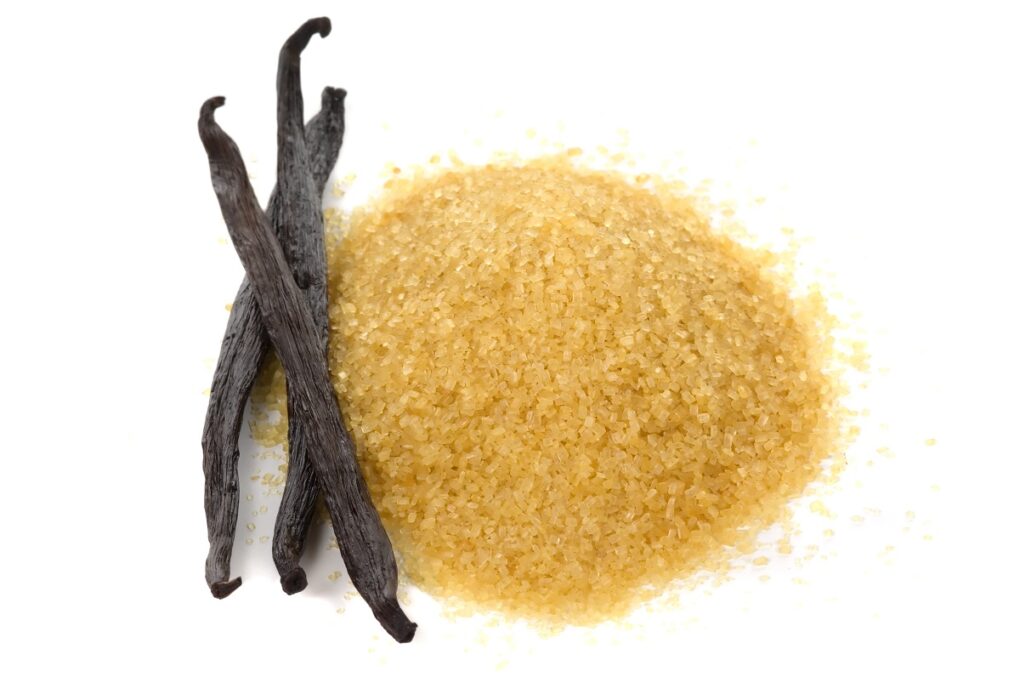
Honey
Most of us have some honey at home. Known for its prominent sweet floral notes, this is one of the most popular natural sweeteners available in grocery stores. The best and most nutritious kind is raw, organic honey.
While honey’s viscosity isn’t the best to replace vanilla sugar, it may be used if this is what you have on hand. Syrupy and sticky, this will only work if your recipe has some liquid in it. Start with a teaspoon of honey replacing not just the vanilla sugar but also part of the liquid called-for, using it with caution.
Coconut Sugar
Starting off our sugar list is coconut sugar. This type of sugar is minimally processed, made from the sap of the coconut palm tree — not the coconuts. Also called coconut palm sugar, it’s more nutritious than white sugar because it’s fiber-rich (inulin), and contains antioxidants & minerals like zinc, calcium, and potassium. The latter are believed to be able to support bodily functions and lower the risk of blood sugar spikes.
While it has a lower glycemic index than granulated sugar and is known to regulate the way your body absorbs glucose, it has roughly 40% fructose, which can only be broken down in the liver.
As with any sweetener, add in coconut sugar sparingly. As a replacement for vanilla sugar, you can use this plant-based sugar in a 1:1 ratio. When used in baking, you can lessen the portion of this substitute by using ⅔ of a cup in a recipe that calls for a cup of vanilla sugar, but also makes a great dusting sugar.
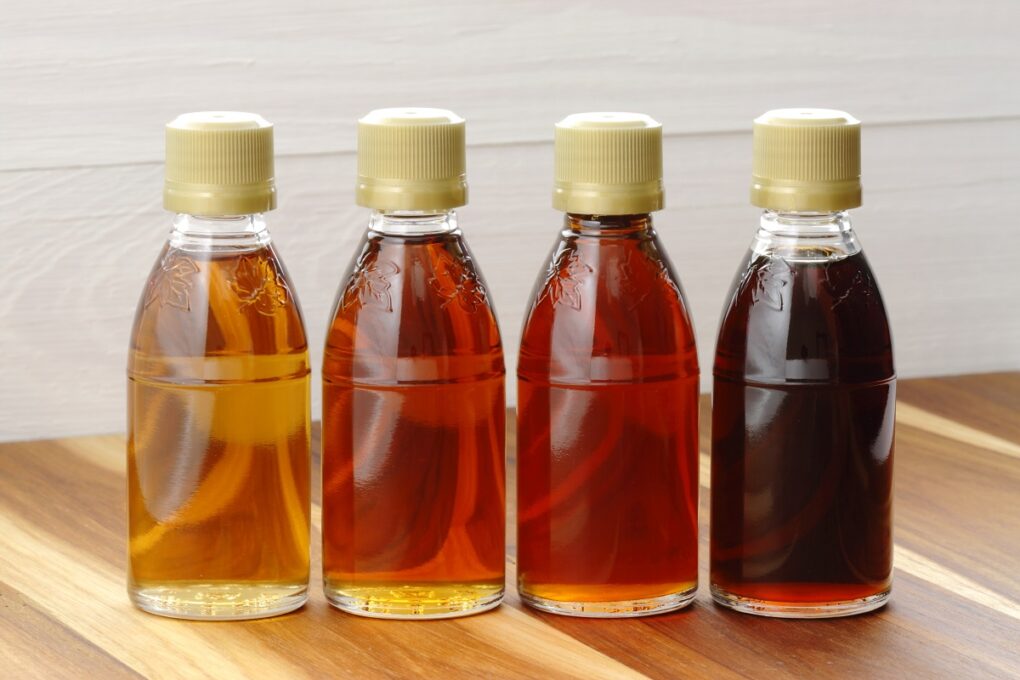
Maple Sugar
Like our first sugar alternative of coconut sugar, maple sugar is a natural and healthier option to replace vanilla sugar. Made from the sap of sugar or black maple trees, maple sugar is known to host at least 25 individual types of antioxidants. It also contains manganese, iron, calcium, zinc, and potassium, which help prevent diseases like Alzheimer’s and even cancer.
To use as a substitute for vanilla sugar, use a 1:1 ratio. Maple has a very distinctive flavor, and it typically shows up much more prominently in your dish. If the maple undertone in place of vanilla don’t bother you, then choose this as a substitute.
Muscovado Sugar
Muscovado sugar is one of the least refined sugars available on the market. It’s made by extracting the juice of sugar cane grass, adding lime, cooking the mixture, letting the liquid evaporate, and then cooling it to form sugar crystals.
With its complex flavor - sweet, somewhat bitter, with just a hint of toffee - this moist, dark brown sugar offers itself as a suitable replacement for vanilla sugar.
Muscovado sugar won’t mimic the flavor of vanilla itself, but it does perform a similar role as vanilla sugar. Use this in a 1:1 ratio to provide richness to baked goods or beverages, or as a finishing sugar. The dark-colored, sandy, grainy topping is great in desserts like sticky rice cakes.

Xylitol (Birch Sugar)
Another type of alcohol sugar is xylitol, which occurs in different types of fruits and vegetables. While it is commercially extracted from corn cob and birch wood, it’s a natural and healthy, non-sugar sweetener. It’s safe for people with diabetes or high blood sugar, and a suitable alternative sweetener for health-conscious people.
Commonly used in sugar-free mints or chewing gum, xylitol lends itself as an easy alternative to vanilla sugar in baked goods in a 1:1 ratio.
Erythritol
A popular white sugar substitute is erythritol. Unlike other natural sugar alternatives, erythritol won’t cause blood sugar levels to spike. This type of sugar alcohol has an extremely similar taste to granulated sugar, one of the key components in vanilla sugar.
You can easily swap a cup of erythritol in a baking recipe for a cup of vanilla sugar. Like other sugar alternatives mentioned, this lacks the vanilla flavor you may be looking for. Add a few drops of vanilla extract into your mixture to bring it closer to the taste of vanilla sugar.
Frequently Asked Questions
Vanilla sugar is used in baking to impart a subtle vanilla flavor to various baked goods, such as cakes, cookies, and pastries.
A good substitute for vanilla sugar is using regular granulated sugar and adding vanilla extract or vanilla bean paste, mixing until you achieve a similar flavor profile.
Vanilla paste can be used as a substitute for vanilla sugar, as it contains both the flavor and the vanilla seeds, providing a similar aromatic quality.
A packet of vanilla sugar typically contains granulated sugar that has been infused with vanilla beans or vanilla extract, used to add a hint of vanilla flavor to recipes.
📖 Recipe

13 BEST Vanilla Sugar Substitutes
Ingredients
Best Vanilla Sugar Substitutes
- DIY Vanilla Sugar w/ Vanilla Bean
- DIY Vanilla Sugar w/ Vanilla Extract
- DIY Vanilla Sugar w/ Vanilla Bean Paste
- DIY Vanilla Sugar w/ Vanilla Powder
- Vanilla Syrup
- Vanilla Extract
- Turbinado Sugar
- Honey
- Coconut Sugar
- Maple Sugar
- Muscovado Sugar
- Xylitol Birch Sugar
- Erythritol
Instructions
- Choose the best vanilla sugar substitute for your particular need.
- Identify exactly how much is needed for your recipe.
- Proceed with your recipe as planned!













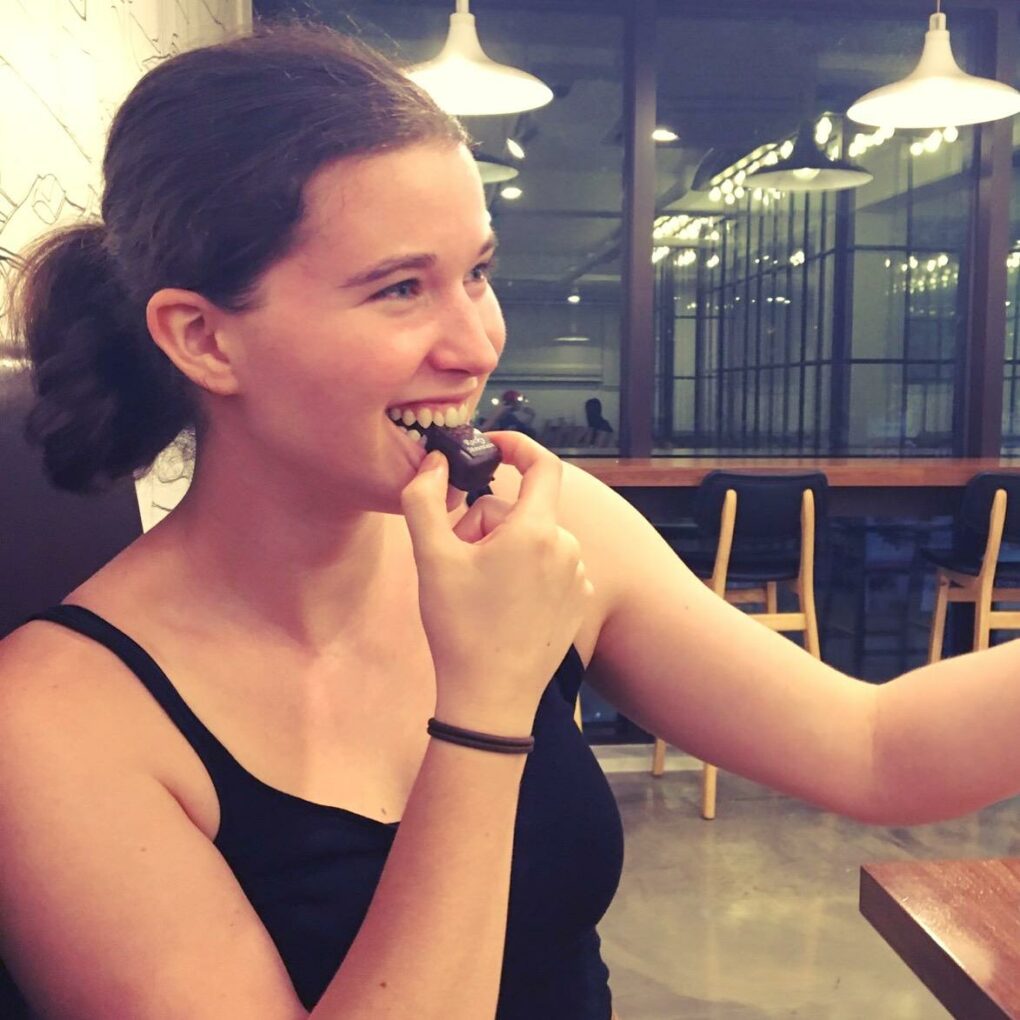
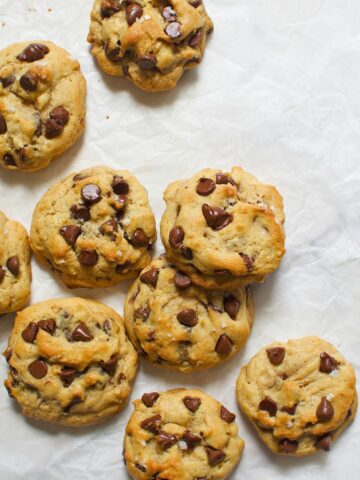

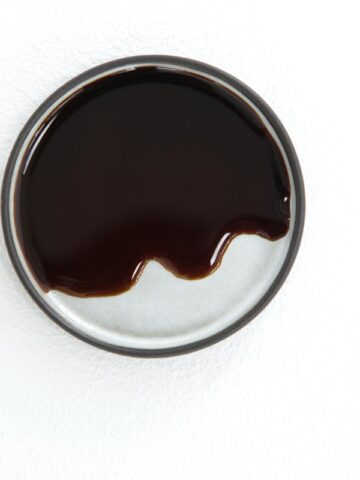
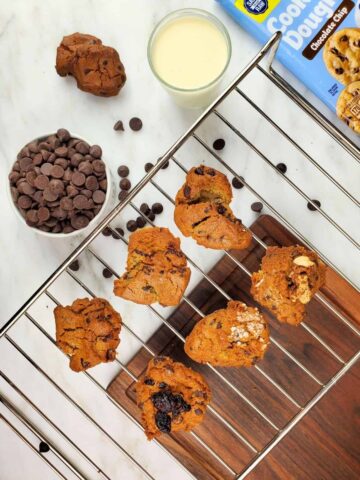
Comments
No Comments